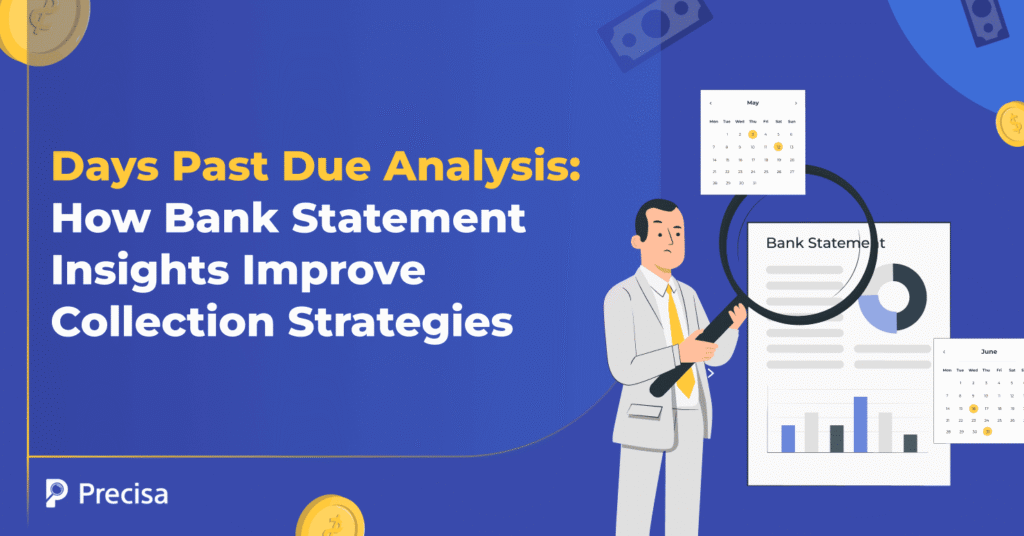Days Past Due Analysis: How Bank Statement Insights Improve Collection Strategies

Late payments continue to challenge lenders, especially in India’s credit-heavy economy. According to the Reserve Bank of India, the 2024 Financial Stability Report indicates the gross non-performing assets of the scheduled commercial banks hit a multi-year low of 2.8 per cent in March of 2024.
Meanwhile, higher delinquency rates have been reflected in some categories of borrowers. A 30-day delay in repayment can signal lenders that the borrower is worse off, and can create a temporary hardship, which may be costly in other ways.
Traditional collection strategies react to problems only after they occur. The reality is that every default starts with a series of missed payments. And these patterns? They can often be spotted early if you know what to look for in days past due analysis
Tech-driven bank statement insights now offer the necessary data intelligence to change collection strategies from reactive damage control to predictive risk management programmes.
Why is Days Past Due Important When Evaluating a Loan Application?
Days Past Due (DPD) tracks how many days a borrower is late on EMI or credit card payments beyond the due date. This straightforward, time-based metric helps assess a borrower’s repayment capability.
Let’s look at how DPD affects lending:
Offers an Early Warning Sign
Days Past Due analysis alerts lenders about potential collection issues before accounts become problematic. When borrowers consistently delay payment by 5-10 days, it often means they are having problems with their cash flow.
Predicts Default Rate
In finance, it’s generally thought that borrowers who are 30 days or more past due are more likely to default within 12 months than borrowers who have never missed a payment.
Helps Segment Risk
Accounts with 1-30 days past due require different collection approaches than those exceeding 90 days. This classification enables lenders to create more focused collection and intervention strategies. As an example, a high-risk account might need to be handled with a field visit or an escalation call, whereas a low-risk borrower should be approached with a reminder call.
This also helps with better resource allocation, higher recovery rates, and lower overall credit losses.
Offers Critical Insights in Unsecured Lending
In cases where no collateral is involved, the borrower’s repayment behaviour is considered the most important risk signal. Analysing DPD trends through bank statement patterns helps lenders assess the intent and ability more accurately than any other credit data.
Ensures Regulatory Compliance
The Reserve Bank of India has stipulated certain provision requirements based on DPD categories. Financial institutions and banks use days past due analysis to determine how much cash they need to set aside, which helps them follow the RBI guidelines and keep their provision buffers healthy.
Key Challenges in Days Past Due Analysis

Despite its value, traditional DPD assessment often faces operational bottlenecks and technical challenges, such as:
Extracting Data Manually
Most lenders rely on applicants’ bank statements and credit reports to analyse DPD. But manually going through hundreds of transactions to determine delayed payments can result in increased errors. A single miscalculation can lead to incorrect provisioning or inappropriate collection actions.
Delay in Tracking Borrowers with Multiple Accounts
For borrowers with multiple loan accounts and bank statements, consolidating all DPDs into a single view is difficult, time-consuming, and increases overhead costs.
Missing the Main Context
Traditional credit reports may show the DPD score, but not the actual root cause of the delay. For example, the reason may have been due to a fund shortage, a mismatch in payment cycle, or a temporary financial crunch.
Complex Analysis Products
Different lending tools use varying DPD calculation methodologies. Credit cards, term loans, and overdrafts each have unique grace periods and calculation rules. Additionally, the collection team often works with outdated data, further missing intervention windows.
Lack of Real-Time Monitoring
Lenders often look at credit history only at the time of disbursement. There’s no way to track DPD in real-time, unless the borrower’s account enters default status.
How Advanced Bank Statement Analysis Enhances DPD Collection Strategies
Bank statement analysis provides a quicker and more accurate way for lenders to gauge the performance of the DPD rate on multiple accounts without necessarily having to wait for a bureau report.
Tracks Cash Flow to Identify Repayment Gaps
Bank statement analysers using artificial intelligence bring out patterns that would otherwise be missed during the manual checks. For example, when borrowers receive income mid-month but have EMI due dates early in the month, they may default on payments despite having sufficient funds later. This allows lenders to adjust the dates of EMIs or send reminders closer to the income cycle, which cuts down on early-stage delinquencies.
In the case of seasonal businesses like retail or hospitality, repayment delays often follow income dips during off-peak months. Bank statement analysis software can help identify these seasonal patterns so that aggressive follow-up actions are avoided when there is a low-income season.
Detects Unusual Income and Spending Behaviour
Applicants like freelancers or home-based business owners generally have irregular income, which often doesn’t show up in traditional documents. But these income patterns can be identified through bank statement transaction data, like UPI transfers, digital payments, or part-time work credits. This helps lenders assess repayment ability more accurately.
Bank statement insights also show spending behaviour. If a borrower continues to pay rent, electricity, and groceries but delays EMIs, it could point to a short-term cash issue rather than unwillingness to pay. This allows teams to take a gentler approach, resulting in a higher response rate.
Enables Better Collection Planning
Bank statement analysis supports better decision-making by:
- Grouping borrowers based on DPD risk patterns, not just DPD count
- Helping lenders schedule follow-ups when the borrower’s account shows available funds
- Reducing manual errors and speeding up action
By using transaction-level insights, lenders can move from standardised collection calls to more informed, borrower-specific communication, making recovery efforts more timely.
The Final Thought
Days Past Due analysis, when assessed alongside bank statement data, serves as a powerful tool for understanding borrowers’ behaviour beyond credit bureau metrics. By enabling early collections, DPD creates an opportunity for lenders to make informed decisions, strengthen their loan portfolio health, and minimise losses in real-time.
Adopting advanced days past due analysis functionalities demands advanced technology that is capable of introducing multisource data, real-time visibility, and interoperability with the existing systems of lending.
Precisa exemplifies this next-generation approach to DPD management. Its automated bank statement analysis combines the DPD-focused capabilities discussed above into a single, comprehensive solution designed specifically for the Indian lending market.
Also, its API integration supports data accessibility and effortless integration with existing loan management and delinquency collection systems.Ready to transform your collection strategy with advanced DPD analysis?
Discover how Precisa can integrate seamlessly with your existing operations while reducing costs and improving recovery rates.
Book a demo with our experts today to see the difference data-driven insights can make.



